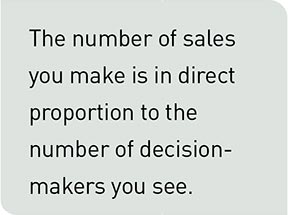HOME | ABOUT US | MEDIA KIT | CONTACT US | INQUIRE
HOME | ABOUT US | MEDIA KIT | CONTACT US | INQUIRE

 */?>
*/?>
The prospect tells you, “I only need one more approval and the order is yours.”
For joy, for joy—the order is mine! Ummmm . . . don’t celebrate too soon. The one last person needed to approve, is the real decision maker. The boss. The guy you were supposed to be talking to in the first place. The one person who can say “no,” and there’s no possibility of reversing it. Rut-row.
Throw some water on yourself, pal. This sale hangs by a thread—and what are you doing about it? Going home and bragging “it’s in the bag,” or saying over and over—“I hope I get it, I hope I get it?” Neither will work.
Here’s what to do: The words “I only need one more approval and the order is yours” must trigger your response to the prospect—“Great, when do we all meet?”
Get the prospect to agree to let you attend the final decision meeting.

If you’re not present when the last decision is made, odds are you will lose the final battle of the sales war without firing one bullet.
Try this: (In a non-salesy, friendly way), say to the prospect, “I’m an expert at what I do, and, Mr. Jones, you’re an expert at what you do. Surely as you discuss our service, questions about productivity and profitability will arise. I’m sure you agree that the right information needs to be presented so that the most intelligent decision can be made, true? (Get commitment!)
“And questions might arise about our service. I’d like to be there to answer questions about my expertise so you can make a decision that’s in the best interest of your business.”
If the prospect agrees to the meeting, he or she considers you a resource, a partner. They trust you. If they don’t agree to let you in the meeting—they just consider you a salesperson.
When others need to “final approve” the deal, besides learning to know the buying process better, you must take these five action steps or the sale is in jeopardy…
1. Get the prospect’s personal approval. “Mr. Prospect, if it was just you, and you didn’t need to confer with anyone else, would you buy?” (The prospect will almost always say yes). Then ask, “Does this mean you’ll recommend our service to the others?” Get the prospect to endorse you and your service to the others, but don’t let him (or anyone) make your pitch for you.
2. Get on the prospect’s team. Begin to talk in terms of “we,” “us,” and “the team.” By getting on the prospect’s team, you can get the prospect on your side of the sale.
3. Arrange a meeting with all deciders. Do it any (ethical) way you have to.
4. Know the prime decider in advance. “Tell me a little bit about the others.” Write down every characteristic. Try to get the personality traits of the other deciders.
5. Make your entire presentation again. You only have to do this if you want to make the sale. Otherwise, just leave it to the prospect. He thinks he can handle it on his own, and will try his best to convince you of that.
If you think you can get around these five steps, think again. (It’s obvious you’re looking for shortcuts or you would have known the buying process in the first place.)
If you make the mistake of letting your prospect become a salesperson on your behalf (goes to the boss or group instead of you), you will lose. Most every time.
A few ounces of prevention (for next time):
1. Qualify the decision maker as the “only” by asking a seemingly innocent question at the beginning of your presentation: “Is there anyone else you work with (confer with, bounce things off of) on decisions (situations) like this?” The objective is to find out if anyone else is involved in the decision before you make your presentation.
2. Prevent the situation from occurring by saying in your initial presentation: “If you’re interested in our ——-, when we’re finished, would it be possible to meet the CEO and chat about it?”
3. The most powerful qualifying question you can ask is (AND IT MUST BE ASKED EXACTLY THIS WAY): “Bill, how will this decision be made?” Bill will give you an answer. AND YOU FOLLOW UP WITH THE QUESTION: “Then what?” And Bill will begin to give you the saga about how the decision is really made. You ask “then what?” four or five times and PRESTO!, you’ll have the name of the real decision-maker.
The number of sales you make will be in direct proportion to the number of actual decision-makers you see. The problem with most salespeople (not you, of course) is that they are sitting in front of someone who has to ask their mommy or daddy if they can buy it or not.
Real salespeople sit in front of real decision-makers. How real are you?